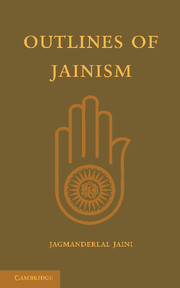CHAPTER IV - RITUAL
from OUTLINES
Published online by Cambridge University Press: 05 June 2016
Summary
This relates to the pursuit of the path of salvation in communion with people living in accordance with Jainism. The object of ritual is the ideal, the goal, namely, truth, perfection, the perfect soul. Ritual is the way in which we manifest our love and reverence for our ideal. It is the enjoyment of what is beyond us, until devotion becomes ecstasy and we feel that we are what we considered to exist outside us, that we are one with the goal, and that the ideal is realized within ourselves.
The subject is long and complicated and concerns, in the main, the esoteric side of Jainism. But one or two points may be noticed.
Knowledge may be derived by considering four aspects of the thing known: ndma, sthdpand, dravya, and blidva, or its name, status, substance, and nature, e.g. we may adore our ideal soul as typified in Lord Mahavira. The name of Mahavira evokes the ideal before our eyes in all its glory ; the thrill with which it is accompanied is our true worship. So in the soldier's breast “ Napoleon ” and “ Alexander ” arouse thrills of reverence which are akin to feelings of worship. This is the ndma point of view.
The second method, sthdpand, is the installation of the adored one in a material representation : photograph, picture, keepsake, image, model, statue—these are examples. Absent friends can be loved and remembered by this means; absent guides can be reverenced; absent ideals can be worshipped. It is a mistake to call this idol-worship; it is ideal-worship and eminently useful. Like all useful things, it may be abused; but that is hardly a sufficient reason for discarding it.
The third view-point is dravya, the thing or person which is to become in the future: for example, respect given to the Prince of Wales as the future King of England, and so forth. It is in this way that the future Tirthankaras can be worshipped in Jainism.
But it must never be forgotten that it is no one person in particular that the Jainas worship.
- Type
- Chapter
- Information
- Outlines of Jainism , pp. 74 - 76Publisher: Cambridge University PressPrint publication year: 2013



